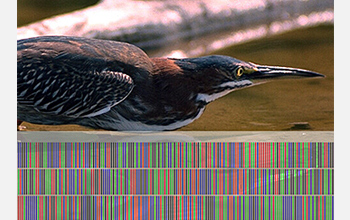Home > Press > DNA Barcodes: Are They Always Accurate?
 |
| This heron is shown with its "DNA barcode," which provides biologists with information about its relationship to other animals.
Credit: Biodiversity Institute of Ontario |
Abstract:
DNA barcoding is a movement to catalog all life on earth by a simple standardized genetic tag, similar to stores labeling products with unique barcodes. The effort promises foolproof food inspection, improved border security and better defenses against disease-causing insects, among many other applications.
DNA Barcodes: Are They Always Accurate?
Arlington, VA | Posted on August 25th, 2008But the approach as currently practiced churns out some results as inaccurately as a supermarket checker scanning an apple and ringing it up as an orange, according to a new Brigham Young University (BYU) study.
The results are published online this week in the journal Proceedings of the National Academy of Sciences (PNAS). The researchers recommend specific quality control procedures to ensure that correct genes are captured.
"It's important to test any scientific tool because all have limits--some situations are more suited than others for barcode use," said Rick McCourt, program director in the National Science Foundation (NSF)'s Division of Environmental Biology, which funded the work. "This research could help clarify the answer to that question."
Organisms can be identified no matter what stage of life they are in. For example, larvae of malaria-carrying mosquitoes contain the same DNA as the adult version of the insect targeted for eradication. The portion of the gene selected as the universal marker by the barcoding movement is part of the genome found in an organism's mitochondria. But the BYU study showed the current techniques can mistakenly record instead the "broken" copy of the gene found in the nucleus of the organism's cells.
This non-functional copy can be similar enough for the barcoding technique to capture, but different enough to call it a unique species, which would be a mistake.
With the International Barcode of Life project seeking to build on the 400,000 species that have been "barcoded" to date, this goal warrants more careful execution, the BYU team says.
"To have that kind of data is hugely valuable, and the list of applications is endless and spans all of biology," said PNAS paper co-author Keith Crandall, a biologist at BYU. "But it all hinges on building an accurate database. Our study is a cautionary tale--if we're going to do it, let's do it right."
Proponents of DNA barcoding seek to establish a short genetic sequence as a way of identifying species in addition to traditional approaches based on external physical features.
Their aim is to create a giant library full of these sequences. Scientists foresee a future handheld device like a supermarket scanner--a machine that would sequence a DNA marker from an organism, then compare it with the known encyclopedia of life and spit out the species' name.
This new approach requires only part of a sample. A feather left behind by a bird struck by an airliner, for example, would be enough to indicate its species and clue officials how to prevent future collisions.
"Building a genetic library of all life is a great goal," said Song, "but we need to pay careful attention to the data that go into that library to make sure they are accurate."
"Scientists have been so preoccupied with creating a barcode of life, that they have not been careful in monitoring the accuracy of the underlying data," BYU scientist Michael Whiting said.
####
About National Science Foundation
The National Science Foundation (NSF) is an independent federal agency that supports fundamental research and education across all fields of science and engineering, with an annual budget of $6.06 billion. NSF funds reach all 50 states through grants to over 1,900 universities and institutions. Each year, NSF receives about 45,000 competitive requests for funding, and makes over 11,500 new funding awards. NSF also awards over $400 million in professional and service contracts yearly.
For more information, please click here
Contacts:
Cheryl Dybas
NSF
(703) 292-7734
Michael Smart
BYU
(801) 372-4011
Copyright © National Science Foundation
If you have a comment, please Contact us.Issuers of news releases, not 7th Wave, Inc. or Nanotechnology Now, are solely responsible for the accuracy of the content.
| Related News Press |
|
|
||
|
|
||
| The latest news from around the world, FREE | ||
|
|
||
|
|
||
| Premium Products | ||
|
|
||
|
Only the news you want to read!
Learn More |
||
|
|
||
|
Full-service, expert consulting
Learn More |
||
|
|
||








